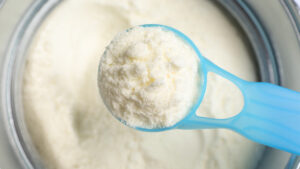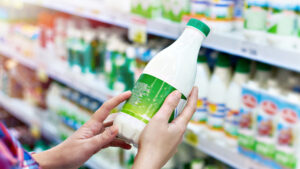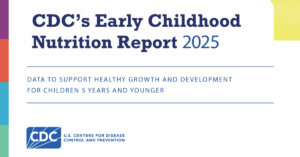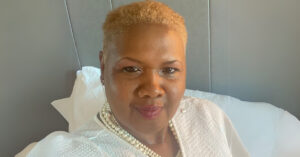Can pasta that is made from 100% bean flour credit towards the grains component?
Read MoreUSDA and HHS each released a notice stating that many programs under the jurisdiction of both departments are now interpreted as “Federal Public Benefits,” including all CNPs and Head Start. The notices aim to address whether citizenship or qualified immigration status must be verified in order for a child to participate in these federal programs.
Read MoreThe National CACFP Association (NCA) will participate in the School Nutrition Association’s Annual National Conference (ANC), taking place July 13–16, 2025, at the Henry B. González Convention Center in San Antonio, Texas.
Read MoreDoes corn credit as a vegetable or a grain in the CACFP?
Read MoreFor summer 2024, USDA recognized 199 winners from all seven FNS regions, with a total of 86 gold, 91 silver, and 22 bronze recipients. Congratulations to all awardees and thanks to everyone working to ensure both food and nutrition security for our nation’s children during the summer months.
Read MoreFarm to CACFP connects providers to local food producers with the objectives of serving locally-grown foods and providing nutrition education. Check out these upcoming events at NCA!
Read MoreFarm to CACFP connects providers to local food producers with the objectives of serving locally-grown foods and providing nutrition education. Check out these upcoming events at NCA!
Read MoreThe National CACFP Association (NCA) proudly announces the 2026 National Child Nutrition Conference (NCNC26), celebrating 40 years of advancing nutrition in child and adult care settings across the country.
Read MoreThe National CACFP Association (NCA) is reaffirming its commitment to continuing education by offering a variety of virtual training opportunities that support child nutrition professionals at every stage of their careers.
Read MoreServing reimbursable meals begins with a solid understanding of the CACFP meal pattern. Learn more with our Meal Pattern Boot Camp!
Read MoreGet a rundown on all things happening in May at NCA. Annual Training is happening this month. Don’t miss out!
Read MoreCACFP advocacy is central to the mission of National CACFP Sponsors Association (NCA) and NCA is continuously working to support and advocate for you! This year, we’ve ramped up our advocacy work to help raise awareness and expand and improve the CACFP.
Read MoreDuring the Covid-19 pandemic, the Keep Kids Fed Act provided flexibilities that were critical for the ability to continue to provide nutritious meals and maintain operation of the Child and Adult Care Food Program (CACFP).
Read MoreAdvocacy might seem scary, some of our most active advocates admit to being intimidated by advocacy before they got started, but it can be simple. Advocacy can be as simple as telling your friend about your job or posting a picture of the meals you make on social media (really!).
Read MoreThe United States Surgeon General, Dr. Vivek Murthy, released an Advisory on the mental health and well-being of parents, stating an urgent need to support parents, caregivers, and families. Surgeon General’s Advisories are public statements that call the American people’s attention to a critical public health issue that require immediate awareness and action.
Read MoreFNS issued this memorandum to provide further clarification on earlier published guidance documents regarding the collection of race and ethnicity data. In addition, this guidance includes examples of challenges Program operators may encounter and best practices that may be used to collect race and ethnicity data for the CACFP and SFSP.
Read MoreThe Child and Adult Care Food Program has new creditable foods listed on the USDA Food Buying Guide! If you are new to the FBG, this interactive tool allows for easy display, search, and navigation of food yield information. In addition, users can compare yield information, create a favorite foods list, and access tools, such as the Recipe Analysis Workbook (RAW) and the Product Formulation Statement Workbook.
Read MoreThe Child and Adult Care Food Program community asked for more Spanish resources to be available on the National CACFP Sponsors Association website and we heard you! Available now in Spanish are more resources to help sponsors and providers with meal pattern requirements, best practices, and so much more!
Read MoreServing meals to young people year-round benefits children, families, and care providers. To do this, many providers transition from operating the USDA Child and Adult Care Food Program (CACFP) At-Risk Afterschool (ARAS) during the school year to the Summer Food Service Program (SFSP) while school is out. For an overview of the main differences between SFSP and CACFP ARAS, see the comparison chart below.
Read MoreNCA understands that the end of flexibilities will cause challenges for many CACFP sponsors and providers and we commend your continued commitment to providing nutritious meals and snacks to the children or adults in your care. In preparation for the end of the additional reimbursement, we have collected the following resources to help you successfully provide meals even if your available budget decreases.
Read MoreCDC created three new fact sheets for Early Care and Education (ECE) providers about Early Child Nutrition and Feeding. The fact sheets offer tips and best practices for supporting breastfeeding families, information about safe storage and handling of breastmilk, and strategies for introducing solid foods.
Read MoreCan pasta that is made from 100% bean flour credit towards the grains component?
Read MoreDoes corn credit as a vegetable or a grain in the CACFP?
Read MoreIs formula made for toddlers creditable in the CACFP?
Read MoreIf a grain product list enriched grains as the first ingredient, is the product creditable in the CACFP?
Read MoreCan a mixed age group of 1- and 2-year-olds all be served unflavored 1% milk in the CACFP?
Read MoreAre vegetable spirals creditable in the CACFP?
Read MoreThe Child and Adult Care Food Program has new creditable foods listed on the USDA Food Buying Guide! If you are new to the FBG, this interactive tool allows for easy display, search, and navigation of food yield information. In addition, users can compare yield information, create a favorite foods list, and access tools, such as the Recipe Analysis Workbook (RAW) and the Product Formulation Statement Workbook.
Read MoreThe Child and Adult Care Food Program community asked for more Spanish resources to be available on the National CACFP Sponsors Association website and we heard you! Available now in Spanish are more resources to help sponsors and providers with meal pattern requirements, best practices, and so much more!
Read MoreServing meals to young people year-round benefits children, families, and care providers. To do this, many providers transition from operating the USDA Child and Adult Care Food Program (CACFP) At-Risk Afterschool (ARAS) during the school year to the Summer Food Service Program (SFSP) while school is out. For an overview of the main differences between SFSP and CACFP ARAS, see the comparison chart below.
Read MoreNCA understands that the end of flexibilities will cause challenges for many CACFP sponsors and providers and we commend your continued commitment to providing nutritious meals and snacks to the children or adults in your care. In preparation for the end of the additional reimbursement, we have collected the following resources to help you successfully provide meals even if your available budget decreases.
Read MoreCDC created three new fact sheets for Early Care and Education (ECE) providers about Early Child Nutrition and Feeding. The fact sheets offer tips and best practices for supporting breastfeeding families, information about safe storage and handling of breastmilk, and strategies for introducing solid foods.
Read MoreUSDA released their second report on the Study of Nutrition and Activity in Child Care Settings (SNACS-II), which follow their first in 2022. SNACS-II uses data from program year 2022-23 to assess how well children’s diets and CACFP meals align with the Dietary Guidelines for Americans.
Read MoreA recent study by our partners at Child Care Aware® of America reveals that parents across the nation are struggling to find affordable, high-quality child care. The survey shows that parents are piecing together multiple care arrangements and facing challenges balancing work and caregiving.
Read MoreThe CDC’s 2025 Early Childhood Nutrition Report gives us a big-picture look at how young children in the U.S. are eating and growing. It focuses on kids from birth to age 5 and shares important facts about breastfeeding, starting solid foods, eating healthy and how states support good nutrition.
Read MoreThe “Characteristics of Emergency Shelters Participating in the CACFP” study by USDA seeks to better understand the characteristics of CACFP emergency shelters, who they serve, how CACFP fits into their operations, and their challenges with CACFP. The study was conducted in 2023 and collected data from 242 emergency shelters that participate in CACFP in Fiscal Year 2023.
Read MoreA survey was administered in the spring of 2023 of licensed California family child care homes (FCCH) to assess the perceived impacts of the increased reimbursement during the Covid-19 pandemic on CACFP participation and anticipated challenges with reinstated tiered rates.
Read MoreThe USDA recently released a study on the “Characteristics of Adult Day Care Centers that Participate in the USDA’s Child and Adult Care Food Program” which seeks to better understand key characteristics of adult day care centers participating in CACFP.
Read More






































USDA Request for Comment: Documentation Related to Meal Pattern Final Rule
USDA FNS is seeking input from CACFP and SFSP operators on the documentation requirement for operators serving primarily American Indian or Alaska Native children to show their eligibility for the menu planning option allowing them to serve vegetables to meet the grains requirement.
Read More